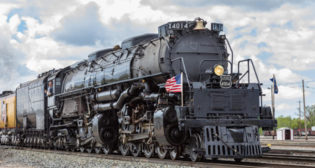
Plans aim to streamline Chicago rail network
Written by Kyra Senese, Managing Editor, Railway Track & Structures
A July 11 tour of Chicago’s rail infrastructure included a stop at Bridgeview’s 71st Street grade separation work near Chicago’s Toyota Park venue, where work is planned to eliminate a grade crossing near the stadium. | Photo: Kyra Senese/RT&S
Officials in the Windy City want to unwind the nation's most complicated railroad labyrinth.
Chicago’s rail network sees about 1,300 freight and passenger trains pass through the city on any given day, and planned work aims to simplify traffic for all of those trains, transportation officials said during a July 11 tour of Chicago rail infrastructure.
Transportation officials conducted a tour of key parts of Chicago’s rail infrastructure to get a glimpse at the work currently under way for the Chicago Region Environmental and Transportation Efficiency (CREATE) Program, as well as to view the sites where future work is planned.
The $4.4 billion plan began in 2003, when transportation officials came together to put an end to bottlenecks in service that halted the flow of goods in and out of the state and interrupted passenger service. CREATE entails 70 rail and highway infrastructure improvement projects. So far, 29 projects have been completed, and $2 billion has been spent or funded primarily through railroad and government partnerships, said Bill Thompson, chief engineer for the Association of American Railroads (AAR).
Officials like Randall Blankenhorn, secretary of the Illinois Department of Transportation (IDOT), hope the CREATE project can serve as an example for how long-term projects can be funded in future years, as state budgets like that of Illinois dwindle and railroads continue to battle it out for federal funding.
“This is an exciting day and an exciting time for us here in Chicago,” Blankenhorn said. “This project is really indicative of what we’re trying to do across the state and across the city in making investments that make a difference in people’s lives. This is the start of something really big for our freight movement and passenger rail system and for our commuters in general.”
Blankenhorn said it is important that government and railroad officials work to find new ways to carry out partnerships.
“I think this project is the way that’s going to happen in the future,” Blankenhorn said. “We all have things that we want to get done and on this project in particular, we all came together with a common goal to figure out how to solve one of the nation’s largest freight bottlenecks.”
This June, the U.S. Department of Transportation (USDOT) recommended 26 projects to receive a total of $1.54 billion in federal support as part of the FY2018 Infrastructure for Rebuilding America (INFRA) grant program.
IDOT was recommended for a $132 million award for a group of projects known as the 75th Street Corridor Improvements and Argo Connections. IDOT has also awarded $49 million in Competitive Freight grant funding to the CREATE program, which representatives said will allow for the start of construction on the 75th Street Corridor and Columbus Avenue projects.
The 75th Street Corridor Improvement Project (CIP) is the largest project within the CREATE program and is intended to relieve congestion by separating freight and passenger rail lines to eliminate bottlenecks, cut down on freight and passenger service delays and reduce train idling.
The 75th Street CIP carries an estimated cost of $474 million and will entail building the flyover and performing track and signal improvements to allow for increased train speeds.
The program is also set to minimize delays at grade crossings and improve safety for motorists. In total, 25% of U.S. freight rail traffic and 46% of all intermodal traffic travels through Chicago, officials said.
When completed, the CREATE program is expected to generate $31.5 billion in the region during the next three decades. Officials also estimate that the program will enable the region to handle up to 50,000 more freight trains per year by 2051.
The July 11 tour included stops at the 75th Street viaducts, as well as a tour of Bridgeview’s 71st Street grade separation work near Chicago’s Toyota Park venue, where work was completed to eliminate a grade crossing near the stadium to improve safety for pedestrians.
Officials also took those on the tour to view the Forest Hill Flyover, which received funds from the $132 million INFRA grant.
The project is set to ease operations for CSX, Union Pacific, Canadian National, Canadian Pacific and Belt Railway of Chicago (BRC) trains, as well as for Metra and Norfolk Southern trains, at what officials said is the most concentrated bottleneck in the Chicago Terminal – Belt Junction.
The site is also the point where officials said 30 Metra and 90 freight trains cross paths each day.
Attendees also got the chance to see the Englewood Flyover, an aspect of the CREATE program that is already complete, which was described as a preview of what the planned 75th Street Forest Hill Flyover will look like when work wraps up.
The flyover is scheduled to be built throughout the next five years, with construction expected to start in the spring of 2019, following the winter thaw.
Thompson said the design phase is funded and will be completed before the flyover is built, and CSX will then build a bypass adjacent to the existing tracks for use while the bridge is being built.
“What we’re going to do going forward in the next couple of years is we’re going to build the Argo project. We have all the projects finished on the Beltway Corridor, except the Argo project and several grade separations,” Thompson said.
Thompson added that if the 75th Street CIP is built in its entirety, all the design and construction is expected to total at about $1 billion.
“There’s basically four projects. We’re going to design 75th Street in its entirety and then we have funding to be able to construct one of the flyovers,” he said. “Our goal right now is to get that flyover started and separate those railroads to ease up operations for Southwest service and ease up the freight operations through one of the most congested locations in the country. That’s our plan forward.”



